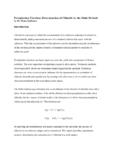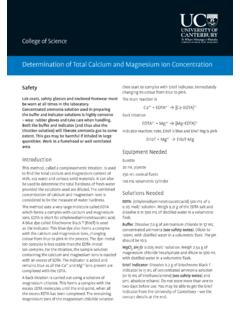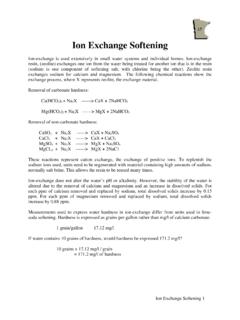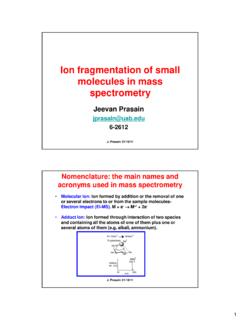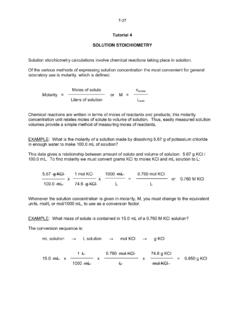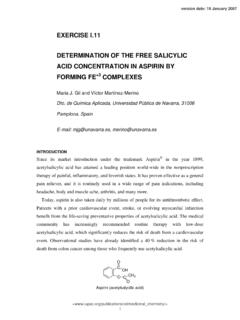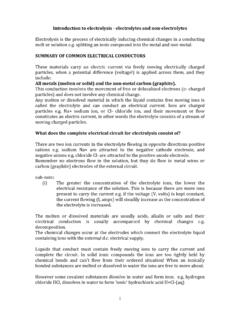Transcription of CHEMISTRY 12 SOLUBILITY REVIEW QUESTIONS
1 SOLUBILITY REVIEW QUESTIONS SOLUBILITY Problem Set 1 1. What is the SOLUBILITY of calcium sulphate in M, g/L, and g/100 mL? 2. What is the SOLUBILITY of silver chromate? In a saturated solution of silver chromate, what is the concentration of each ion? 3. What is the SOLUBILITY of silver chromate in a solution that is M in silver nitrate? 4. What is the maximum concentration of chromate ion that is allowed before silver chromate will precipitate if the silver ion concentration is x 10-4 M? 5. How many lead(II) and iodate ions are present in L of a saturated solution of lead(II) iodate? 6. Will a precipitate form if 34 mL of x 10-3 M lead(II) nitrate are mixed with 79 mL of x 10-3 M sodium iodate? 7. How many precipitates will form if 25 mL of x 10-2 M magnesium sulphate is mixed with L of x 10-2 M strontium hydroxide?
2 8. How many grams of magnesium carbonate are dissolved in L of a saturated solution? 9. Devise a method to separate the following ions from a mixture and provide a net ionic equation for each step: a) Ag+, Sr2+, and Cu2+ b) SO32-, SO42-, and Br- 10. Describe the changes to rate(dissolving), rate(crystallizing), SOLUBILITY ( s ), and Ksp when additional compound is added to an already saturated solution of the compound. Answers to SOLUBILITY Problem Set 2 (for QUESTIONS on the other side): 1. x 10-19 2. [Ca2+] = [SO42-] = x 10-3 M 3. [Ca2+] = x 10-4 M, [F-] = x 10-4 4. x 10-15 g/L 5. KTIP = x 10-7 ppt forms 6. KTIP = x 10-7 ppt forms 7. a) x 10-5 b) x 10-9 8. Ksp (at temperature X oC) = x 10-8, X oC > 25 oC 9.
3 X 10-3 M (pure water), x 10-4 M ( M Pb(NO3)2) 10. a) Sr2+ b) [Sr2+] = x 10-3 M 11. x 101 mL 12. M SOLUBILITY REVIEW QUESTIONS SOLUBILITY Problem Set 2 1. In a saturated solution of FeS, the [Fe2+] and the [S2-] are both x 10-10 M. Calculate the value of Ksp. 2. Find [Ca2+] and [SO42-] in a saturated solution of CaSO4. 3. Find [Ca2+] and [F-] in a saturated solution of CaF2. Ksp for CaF2 is x 10-11. 4. Find the SOLUBILITY of Ag2S in water in g/L. Ksp for Ag2S is x 10-49. 5. Will a precipitate form if mL of M AgNO3 is mixed with mL of M Na2CO3? 6. Will a precipitate form if mL of M AgNO3 is added to mL of a solution containing mg of bromide ions? (How does the mass of Br compare to Br-?) 7. Calculate the Ksp for each of the salts whose SOLUBILITY is: a) CaSO4: x 10-3 M b) SrF2: mg/100 mL.
4 8. Can the temperature of L of a saturated AgCl solution containing 38 mg of dissociated AgCl be 25 oC? If the dissociation of the solid phase to the aqueous phase is endothermic, how does the temperature of this saturated solution compare to one at 25 oC? 9. Compare the molar SOLUBILITY of PbI2 in pure water and in M Pb(NO3)2. 10. A L solution contains M Ag+ ions and M Sr2+ ions. a) Which ion precipitates first when K2CO3 is added to the mixture? Assume no change in volume. b) What is the concentration of the ion that is precipitated first when the second ion begins to precipitate? 11. Barium nitrate reacts with potassium sulphate solution and forms insoluble barium sulphate. What volume of M Ba(NO3)2 solution is required to precipitate the sulphate ions in mL of M K2SO4?
5 12. A 225 mL sample of tap water containing the chloride ion requires mL of M AgNO3 to titrate. What is the chloride concentration in the tap water? Answers to SOLUBILITY Problem Set 1 (for QUESTIONS on the other side): 1. x 10-3 M, g/L, g/100 mL 2. s = x 10-5, [Ag+] = x 10-4 M, [CrO42-] = x 10-5 M 3. x 10-11 M 4. x 10-6 M 5. x 1020 Pb2+ ions, x 1020 IO3- ions 6. KTIP = x 10-8 > Ksp, therefore a ppt will form 7. KTIP (Mg(OH)2) = x 10-5, KTIP (SrSO4) = x 10-4, two ppt s form 8. g 9. a) 1. add NaCl: Ag+(aq) + Cl-(aq) -----> AgCl(s) (filter) 2. add Na2SO4: Sr2+(aq) + SO42-(aq) -----> SrSO4(s) (filter) 3. add Na3PO4: 3 Cu2+(aq) + 2 PO43-(aq) -----> Cu3(PO4)2(s) (filter) b) 1.
6 Add Mg(NO3)2: Mg2+(aq) + SO32-(aq) -----> MgSO3(s) (filter) 2. add Ba(NO3)2: Ba2+(aq) + SO42-(aq) -----> BaSO4(s) (filter) 3. add Pb(NO3)2: Pb2+(aq) + 2 Br-(aq) -----> PbBr2(s) (filter) 10. rate(dissolution) = increase, rate(crystallization) = increase, s = no change, Ksp = no change SOLUBILITY REVIEW QUESTIONS 1. The equation for silver chromate dissolving in water is Ag2 CrO4(s) 2 Ag+(aq) + CrO42-(aq) What is the Ksp expression? a) [Ag+]2[CrO42-] b) [Ag+][CrO42-]2 c) [2 Ag+][CrO42-] d) [Ag+]2[CrO42] / [Ag2 CrO4] 2. What is the SOLUBILITY of silver chloride, AgCl, in water, given Ksp (AgCl) = 10-10 ? a) 10-20 M b) 10-10 M c) 10-5 M d) 10-3 M 3. What is the SOLUBILITY of lead II iodide (PbI2) in water, given Ksp (PbI2) = 10-9 ?
7 A) 10-9 M b) 10-5 M c) 10-3 M d) 10-3 M 4. mL of 10-5 M AgNO3 and mL of 10-4 M NaCl are mixed. Ksp (AgCl) = 10-10. Which one of the following occurs? a) Ion product is 10-10 and precipitate forms. b) Ion product is 10-10 and precipitate does not form. c) Ion product is 10-9 and precipitate forms. d) Ion product is 10-9 and precipitate does not form. 5. What is the highest concentration of magnesium ion possible at equilibrium in a solution containing 10-2 M oxalate ions (C2O42-) given that Ksp (MgC2O4) = 10-5 ? a) 10-3 M b) 10-2 M c) 10-1 M d) 10-2 M 6. What is the equilibrium concentration of Sr2+(aq) in a saturated aqueous solution of SrSO4 ? (Ksp of SrSO4 = 10-7 ) a) 10-7 M b) 10-7 M c) 10-4 M d) 10-3 M SOLUBILITY REVIEW QUESTIONS 7.
8 PbCl2 (s) is precipitated from a solution containing Pb2+(aq) and Cl-(aq). Which one of the following relationships describes the concentrations of the ions remaining in the solution? a) [Pb2+]2[Cl-] = Ksp of PbCl2 (s) b) [Pb2+]2[Cl-]2 = Ksp of PbCl2 (s) c) [Pb2+][Cl-] = Ksp of PbCl2 (s) d) [Pb2+][Cl-]2 = Ksp of PbCl2 (s) 8. Which one of the following statements is TRUE about the result of mixing equal volumes of M CaCl2 and M Na2SO4? (Ksp for CaSO4 (s) = x 10-5) a) The trial product is smaller than the Ksp and a precipitate will form. b) The trial product is larger than the Ksp and a precipitate will form. c) The trial product is smaller than the Ksp and a precipitate will not form. d) The trial product is larger than the Ksp and a precipitate will not form.
9 9. The Ksp for the salt MA2 is 10-6. What is the [M2+] in a saturated solution formed by dissolving MA2 (s) in water? a) 10-3 M b) 10-3 M c) 10-2 M d) 10-2 M 10. Silver acetate, AgCH3 COO(s), crystals are in equilibrium with a saturated solution. Which of the following would cause more AgCH3 COO(s) to dissolve? a) The addition of a few crystals of silver nitrate. b) The addition of a few drops of concentrated nitric acid. c) The addition of a few crystals of sodium acetate. d) The evaporation of some water from the solution with no temperature change. 11. L of a saturated solution of thallium bromide (TlBr) was evaporated to dryness to produce g of TlBr(s). What is the Ksp of thallium bromide? (molar mass of TlBr = 284 g / mol) a) 10-6 b) 10-6 c) 10-3 d) 10-2 12.
10 A solution contains Ba2+(aq), Pb2+(aq), Fe2+(aq), and Mg2+(aq). Which of the following negative ions would cause a precipitate with only one of those metals? a) I-(aq) b) SO42- c) NO3-(aq) d) PO43-(aq) SOLUBILITY REVIEW QUESTIONS 13. The Ksp for PbS is 10-28. What is the [S2-] in a saturated solution of PbS? a) 10-10 M b) 10-13 M c) 10-14 M d) 10-28 M 14. Phosphate ions, PO43-, form a compound of low SOLUBILITY with a) NH4+ b) K+ c) H+ d) Ca2+ 15. Some solid NaCH3 COO is added to a saturated AgCH3 COO solution in contact with AgCH3 COO crystals. Which of the following occurs? a) The NaCH3 COO solid does not dissolve. b) More AgCH3 COO dissolves. c) AgCH3 COO precipitates. d) There is no change in the amount of dissolved AgCH3 COO.

